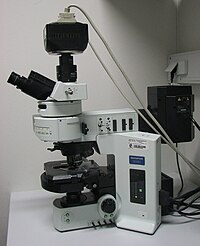Fluorescent microscopy

Fluorescent microscopy is like using a special magnifying glass that helps us see tiny things that are too small for our eyes to see normally. Imagine you are looking for a tiny toy that you lost somewhere in your room, but it's so small you can't see it no matter how hard you try. Fluorescent microscopy helps scientists find tiny things like this.
The first step is to take the thing we want to look at, like a cell or a piece of tissue, and add a special substance called a fluorophore. This is like putting a special light on the toy you lost in your room, so that it will glow in the dark and be easier to see even if it's hiding somewhere.
Next, we put the sample under the special magnifying glass called a microscope. This is like using a really good detective lens to zoom in on the toy you lost in your room, so that you can see every tiny detail of where it might be hiding.
When we look through the microscope, we see the fluorophore glowing brightly against a dark background. This makes it much easier for us to see and understand what we're looking at. It's like using a flashlight to find the toy you lost in your room, so you can see all the nooks and crannies where it might be hiding.
Fluorescent microscopy is used in many different fields, including biology, medicine, and chemistry. Scientists use it to learn more about cells, to study diseases, to develop new medicines, and to understand how different chemicals interact with each other. Thanks to fluorescent microscopy, we can see things that are too small or too hidden for us to see otherwise, and learn more about the world around us.
The first step is to take the thing we want to look at, like a cell or a piece of tissue, and add a special substance called a fluorophore. This is like putting a special light on the toy you lost in your room, so that it will glow in the dark and be easier to see even if it's hiding somewhere.
Next, we put the sample under the special magnifying glass called a microscope. This is like using a really good detective lens to zoom in on the toy you lost in your room, so that you can see every tiny detail of where it might be hiding.
When we look through the microscope, we see the fluorophore glowing brightly against a dark background. This makes it much easier for us to see and understand what we're looking at. It's like using a flashlight to find the toy you lost in your room, so you can see all the nooks and crannies where it might be hiding.
Fluorescent microscopy is used in many different fields, including biology, medicine, and chemistry. Scientists use it to learn more about cells, to study diseases, to develop new medicines, and to understand how different chemicals interact with each other. Thanks to fluorescent microscopy, we can see things that are too small or too hidden for us to see otherwise, and learn more about the world around us.
Related topics others have asked about:
